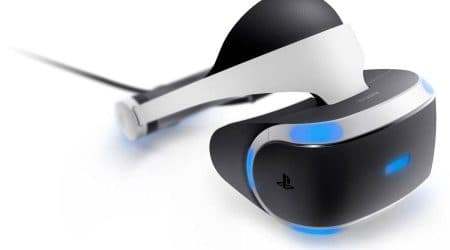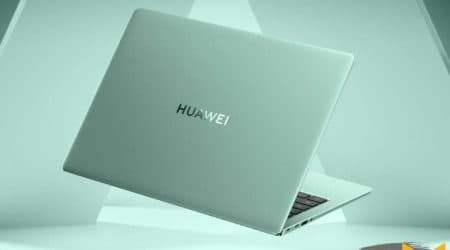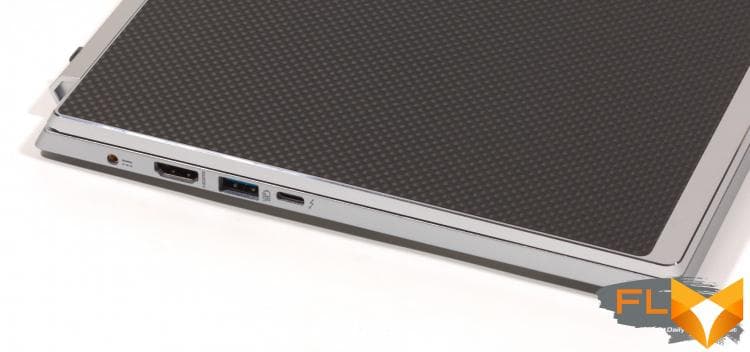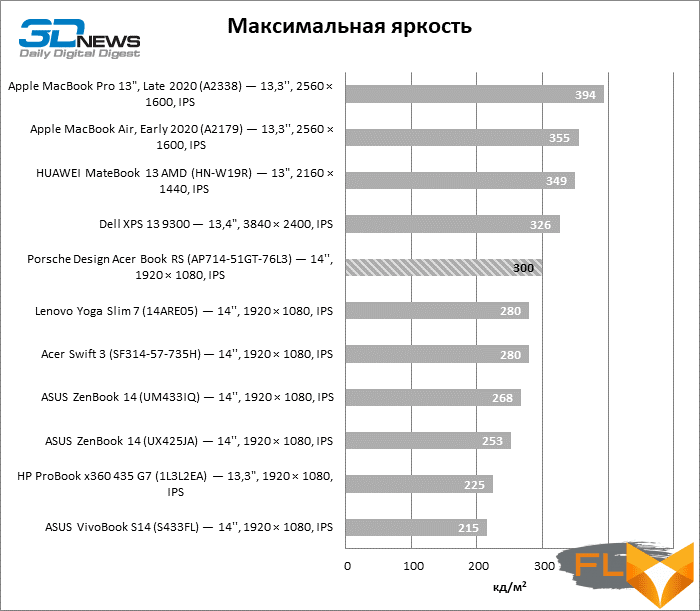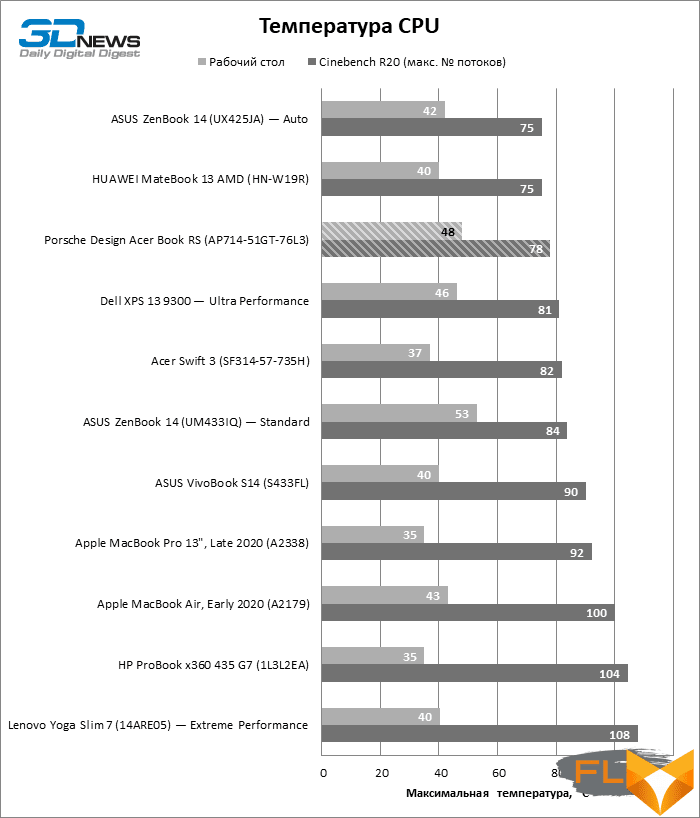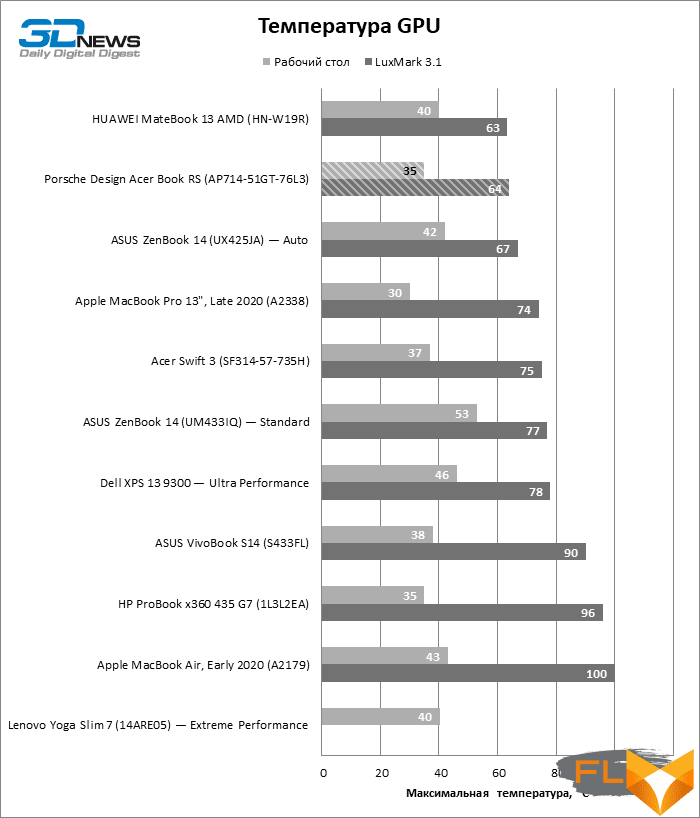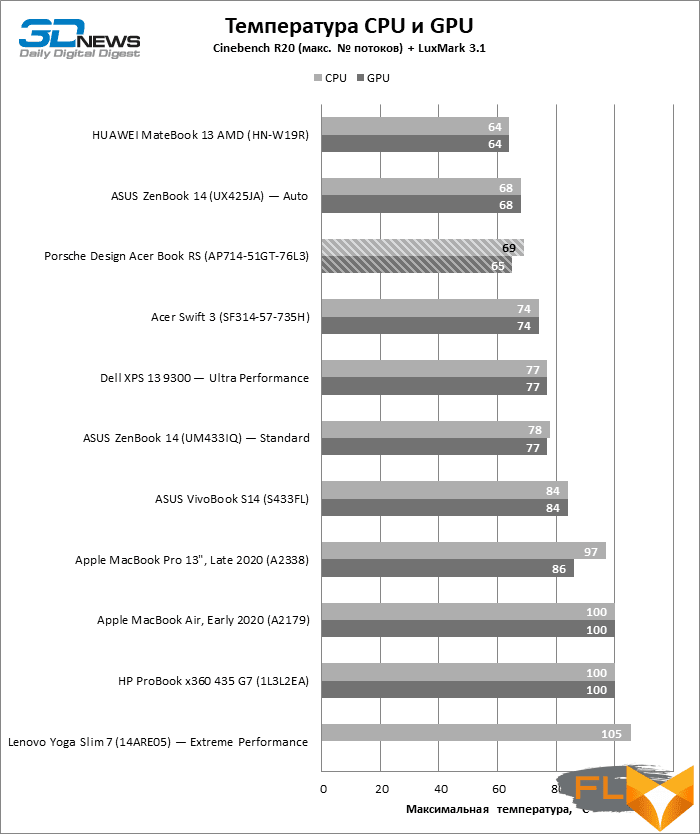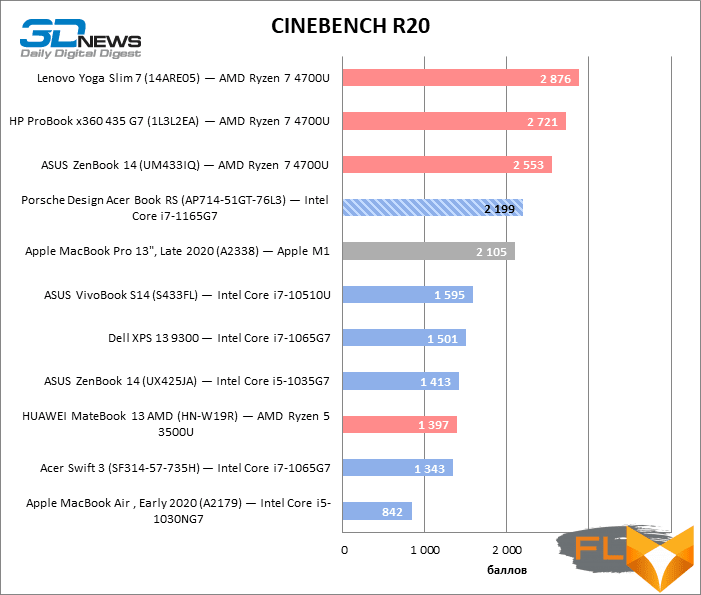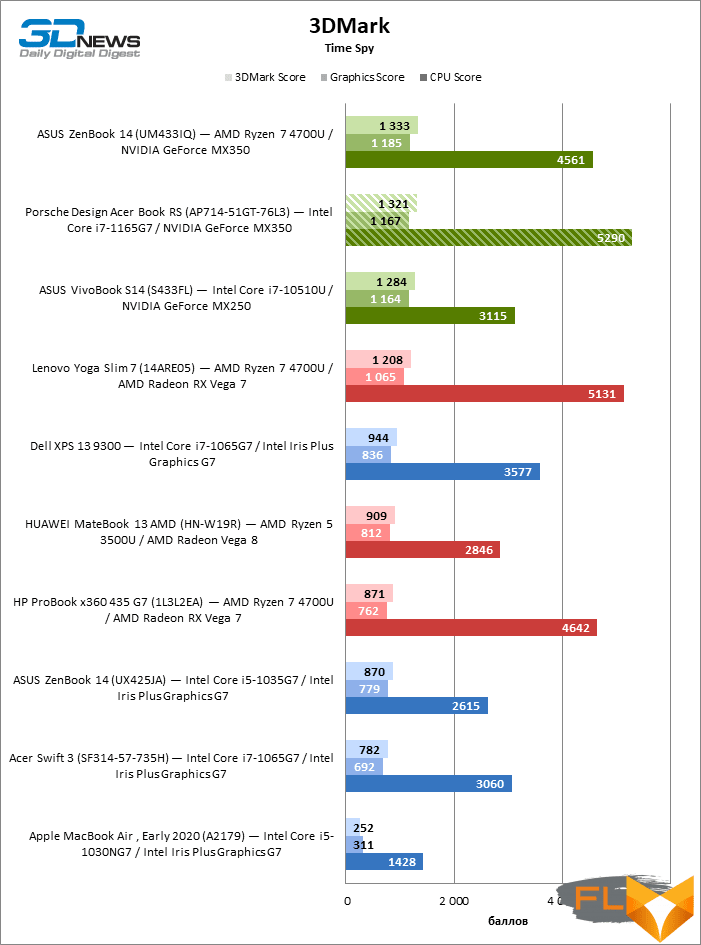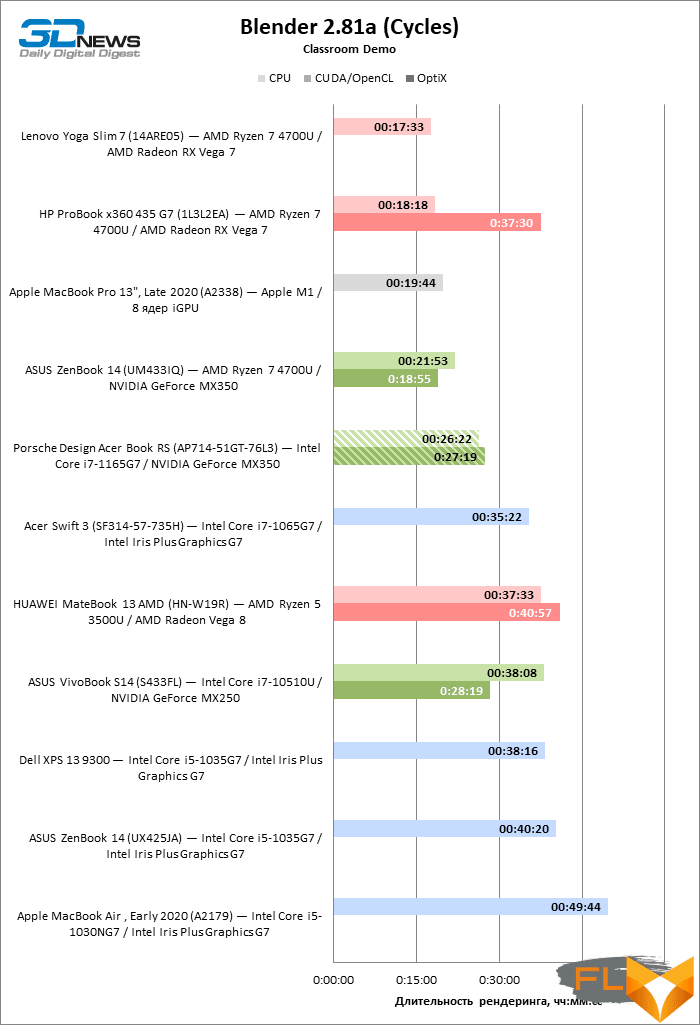


Throughout 2020, all the attention in the compact laptop market has been focused on models based on Ryzen 4000 processors with up to eight cores. But Intel eventually rallied and released a worthy alternative to the “red” ones in the form of Tiger Lake silicon, which will immediately replace all low-wattage Intel CPUs of the past generation – both 14-nanometer Comet Lake and economical 10-nanometer Ice Lake. Intel chips in this power category have not yet grown to eight x86 cores, but the first benchmarks (see our review of the updated version of MSI Modern 15) have shown that there is a wide class of tasks in which the successful Tiger Lake architecture outweighs the large number of Ryzen cores.
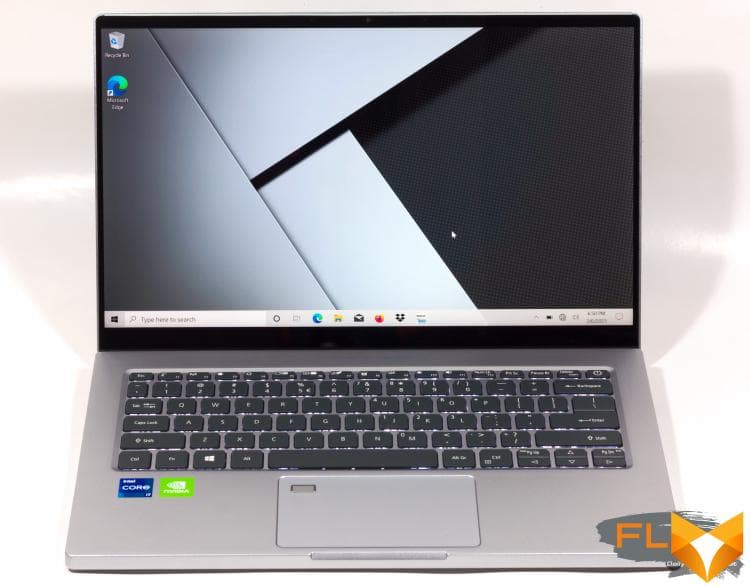
However, the 15-inch laptop chassis that introduced us to Tiger Lake has an advantage in terms of cooling and, accordingly, the reserve of CPU power. The real test awaits Intel in tests of a compact and lightweight machine, such as the latest Porsche Design Acer Book RS laptop, manufactured by Acer, of course. However, advanced silicon is not the only advantage of this computer. The Acer product aims at the most prestigious and expensive category of ultrabooks and has the appropriate capabilities.
⇡#Specifications, prices
Before we study the configuration of the brainchild of Acer, we immediately note that this is a very expensive device. A few online stores estimated the novelty at almost $3,100.
What will the buyer get for such money? If we focus on compressed specifications, leaving the design and design features of the laptop to the end, then the Porsche Design Acer Book RS lineup gives the choice between Core i7-1135G7 and Core i7-1165G7 processors. Both CPUs contain 4 cores with SMT support and Iris Xe integrated graphics, which are quite powerful in their class. However, owners of older configurations will need the latter only for rendering UI applications, encoding / decoding video and other simple tasks, because Acer has equipped the computer with an entry-level discrete GPU GeForce MX350.
RAM is represented by 8 or 16 GB LPDDR4X in dual-channel mode, and the amount of solid-state ROM is 512 GB or 1 TB. Regardless of the filling, the laptop has a Thunderbolt 4 connector combined with a USB 3.2 Gen 2 and DisplayPort interface, and for wireless communications there is a Wi-Fi 6 + Bluetooth module.
Be that as it may, Russian buyers have no choice between different configurations of the Porsche Design Acer Book RS. Judging by the official website of Acer, only the top model is supplied to us, which is sold for the already announced amount.
| Manufacturer | Acer |
|---|---|
| Model | Porsche Design Acer Book RS |
| Display | 14”, 1920 × 1080 (60Hz), IPS, touch |
| CPU | Intel Core i7-1135G7 (4/8 cores/threads, 2.4-4.2 GHz); Intel Core i7-1165G7 (4/8 cores/threads, 2.8-4.7 GHz) |
| RAM | LPDDR4X SDRAM, 4266 MT/s, 8-16 GB (2 channels) |
| GPU | Intel Iris Xe Graphics G7 (system RAM); NVIDIA GeForce MX350 (2GB GDDR5) |
| Drive | SSD (PCIe 3.0 x4) 512/1024 GB |
| External I/O connectors | 2 × USB 3.2 Gen 1 Type-A; 1 × USB 3.2 Gen 2 Type-C (Thunderbolt 4, DisplayPort); 1 x HDMI; 1 x TRS 3.5mm |
| Network | IEEE 802.11ax + Bluetooth 5 |
| Battery capacity, Wh | 54.5 |
| Weight, kg | 1.5 |
| Overall dimensions (L × H × D), mm | 318.7 × 209.2 × 15.99 |
| Retail price in dollars. | 3100 (Porsche Design Acer Book RS, GeForce MX350, 16 GB, 1024 GB) |
⇡#Look and Ergonomics
At the price of the Porsche Design Acer Book RS, buyers of the device are entitled to demand not only high-performance components, but also high quality and ergonomics of the chassis. At first glance, the Acer Book RS fully meets these criteria. The laptop is assembled in an all-metal case made of milled aluminum, and the only exception in terms of materials here is only the cover – a carbon fiber panel is embedded into it (that’s why it is Porsche Design).
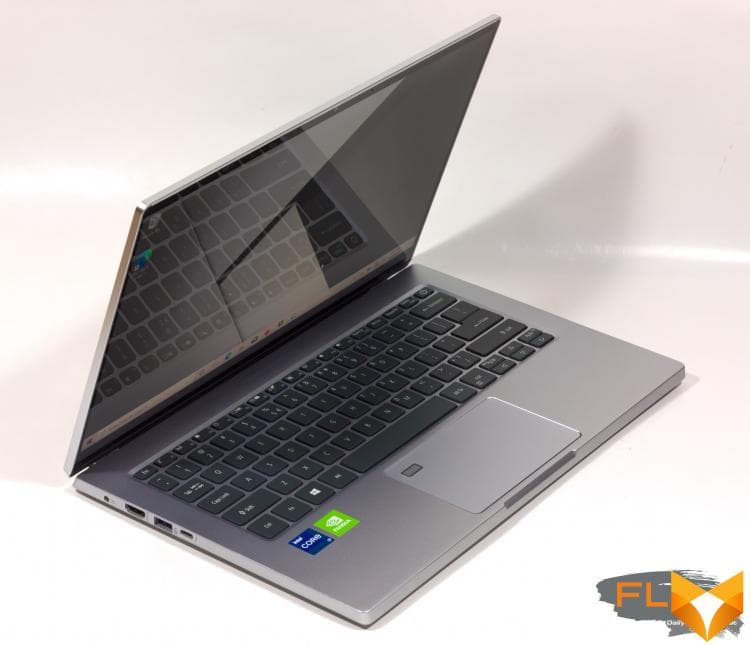
The lid and work surface are connected by one wide hinge – it is not visible from the front when the laptop is open, and, in particular, thanks to this design, Acer managed to squeeze the screen into such narrow frames. The screen itself is touch-sensitive and, as a result, is laminated with glossy glass (with a good, though not outstanding, anti-reflective coating). But the Porsche Design Acer Book RS does not have a tablet mode – the screen does not recline to a large angle.
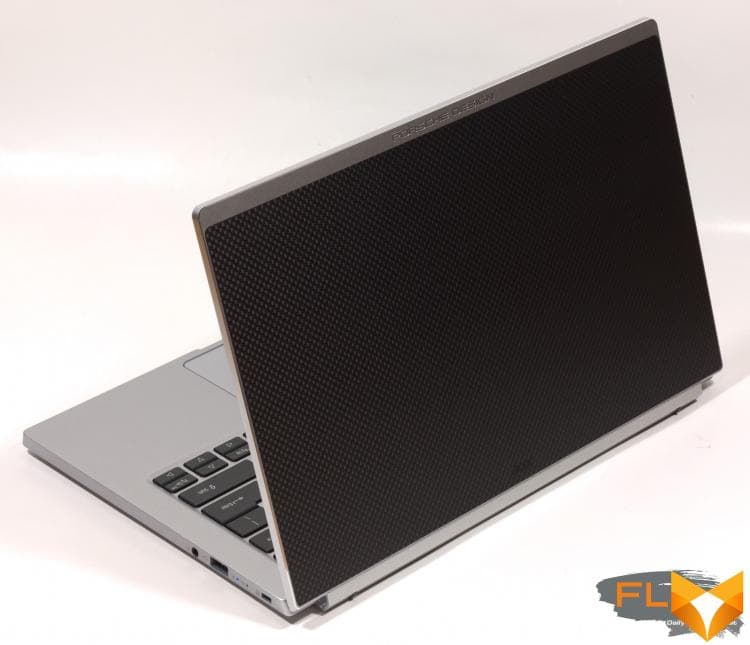
Despite the choice of body materials, Acer turned out to be quite light (1.5 kg) and thin machine. In the closed position, the case is spaced from the work surface by the same height of 16 mm and does not taper towards the front edge. The tilt of the keyboard is set only by the protruding hinge of the screen cover. By the way, it is impossible to lift it with one hand – the hinges are too tight. This is the first claim that we have to the device Porsche Design Acer Book RS.
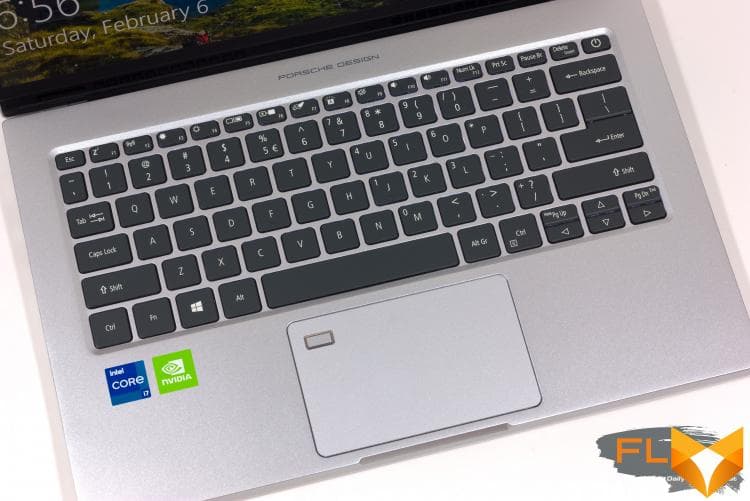
Now we will, as usual, pay close attention to the mechanics of the controls. The keys of the Porsche Design Acer Book RS have a short travel but a precise actuation point and quickly return to their neutral position when pressed. The only pity is that the rise of the case above the table and the layout of the laptop’s innards do not contribute to the rigidity of the base under the keyboard. However, we must pay tribute to Acer, in many laptops of a similar design, the keyboard “plays” even more, but here, when pressed with a little effort, it is practically not felt. Serious questions can arise only to the keyboard layout. There is not much space left in the hollow of the workspace, so the width of some keys had to be sacrificed: Tab and “~” got it. But there would be no need for this if it were not for the increased size of Backspace and “”. Finally, the backlighting of the keys has only two gradations of brightness – you can turn a blind eye to this, but again, not at such a cost of the machine.
The Porsche Design Acer Book RS touchpad is covered with glass (this already corresponds to the level of the device), it works over a large area with a soft click. The touchpad is well fixed in the topcase, does not make any extra sounds, but it is felt that the panel is quite thin and bends easily in the corners. A biometric sensor is built into the manipulator, but it does not interfere with the use of the touchpad for its main purpose, since the surface of the sensor is a kind of continuation of the surrounding panel. But an additional authentication tool that is supported in Windows – an infrared camera – is not in the Porsche Design Acer Book RS.
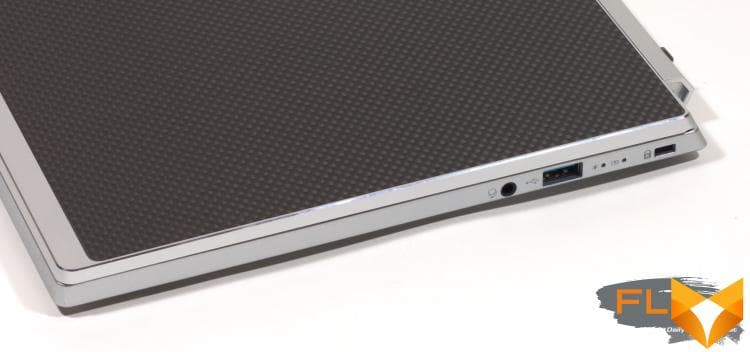
All the necessary connectors are located on the sides of the chassis: three USB ports, one of which is combined with Thunderbolt 4 and DisplayPort interfaces, full-size HDMI and TRS 3.5 mm for connecting external speakers. The Thunderbolt outlet also provides battery charging. Wait, what’s that round hole? It turns out that the Porsche Design Acer Book RS can also be powered through a regular barrel connector, and two power supplies are included at once – with USB Type-C or a barrel plug, so that leave the Thunderbolt socket free . There is no memory card reader here, although there is still plenty of free space on the side faces of the case, and inside, as you will see below, there was enough space.
Built-in stereo speakers Porsche Design Acer Book RS produce the sound you would expect for its modest dimensions: loud enough, but devoid of low frequencies. The main thing is that even at maximum volume in the case, nothing resonates in response to sound waves.

What really surprised the Acer laptop was the generous bundle, which includes not only the notorious power supply, but also a wireless mouse and a case. Even not so, covers – in the plural. One is for the computer itself, the other is for everything else, and for easy portability, they can be chained together on magnets. As for the mouse, due to its angular shape it is not very comfortable to use, and in terms of the quality of the body materials, this mouse is not a pair of Porsche Design Acer Book RS, although it fits the design quite well.

Internal design and upgrade options
Like most modern ultrabooks, the Porsche Design Acer Book RS is not rich in custom upgrade options. The RAM is soldered on the motherboard (and there are no separate LPDDR4X modules), and only an M.2 solid-state drive can be replaced.
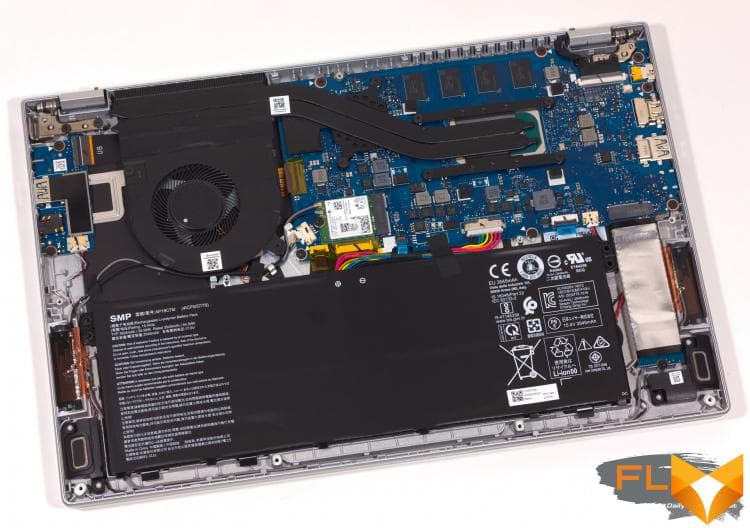
Porsche Design Acer Book RS is equipped with a rather modest-looking cooler, which will take care of cooling not only the low-wattage CPU, but also the discrete GPU. Acer has certainly had to make some trade-offs between performance, component heat and noise levels – we’ll find out soon. Also, pay attention to the fact that some of the external interfaces are soldered on a separate PCB – a useful solution in case of connector failure. The only pity is that not from the side of the power cable, which will be connected to the laptop most often.
⇡#Test Methodology
| Synthetic tests | |
|---|---|
| Application | Settings |
| 3DMark Time Spy | — |
| Geekbench 4 | — |
| CINEBENCH R20 | — |
| GFXBench 5 (Aztec Ruins – Normal Tier, High Tier) | Windows: Vulkan, macOS: Metal |
| fio 3.16 | Sequential Read/Write, Random Read/Write (Unbuffered I/O) |
| Work Applications | |||||
|---|---|---|---|---|---|
| Application | Benchmark | Settings | API | ||
| Intel Graphics | AMD Graphics | NVIDIA Graphics | |||
| Adobe Photoshop CC 2019 | PugetBench for Photoshop CC 0.8 (test structure at link) | Basic Benchmark | OpenGL + OpenCL + Metal (macOS) | OpenGL + OpenCL + Metal (macOS) | OpenGL + OpenCL |
| Adobe Photoshop Lightroom Classic CC 2020 | PugetBench for Lightroom Classic 0.8 (test structure at link) | — | DirectX 12 (Windows) | DirectX 12 (Windows) | DirectX 12 |
| Adobe Premiere Pro CC 2019 | PugetBench for Premiere Pro 0.8 (test structure at link) | Standard Benchmark | OpenCL (Windows)/Metal (macOS) | OpenCL (Windows)/Metal (macOS) | CUDA |
| Blender 2.81a | Class Room Demo from Blender Foundation | Cycles renderer. Feature Set: Supported. Tile size: 32 × 32 (CPU) or 256 × 256 (GPU) | N/A (CPU rendering) | OpenCL | CUDA/OptX |
| AMD Nissan GTR Demo | Radeon ProRender | N/A | OpenCL | OpenCL | |
Display testing is performed using a Datacolor Spyder4 Elite colorimeter in ArgyllCMS and DisplayCAL 3 applications.
Notebook battery life is measured at a display brightness of 200 cd/m2 in the following usage scenarios:
- web surfing: alternately opening and closing tabs of 3DNews.ru, Computeruniverse.ru and Unsplash.com sites with an interval of 25 seconds in the Google Chrome browser (cache and cookies are disabled);
- Continuous playback of 4K HEVC (H.265) video.
⇡#Test participants
The following devices took part in testing:
| Screen | CPU | RAM | GPU | SSD | HDD | Battery | |||
|---|---|---|---|---|---|---|---|---|---|
| Porsche Design Acer Book RS (AP714-51GT-76L3) | 14”, 1920 × 1080, IPS | Intel Core i7-1165G7 | 4/8 cores/threads, 2.8-4.7GHz | LPDDR4X SDRAM, 4266 MT/s, 16 GB | NVIDIA GeForce MX350 | 2GB GDDR5 | WD PC SN530 (PCIe 3.0 x4) 1024 GB | None | 54.5 Wh |
| Lenovo Yoga Slim 7 (14ARE05) | 14”, 1920 × 1080, IPS | AMD Ryzen 7 4700U | 8/8 cores/threads, 2.0-4.1GHz | LPDDR4X SDRAM, 4266 MT/s, 16 GB | AMD Radeon RX Vega 7 | 512MB of system RAM | UMIS RPITJ256VME2MWD (PCIe 3.0 x4) 256 GB | None | 60 Wh |
| Acer Swift 3 (SF314-57-735H) | 14”, 1920 × 1080, IPS | Intel Core i7-1065G7 | 4/8 cores/threads, 1.3-3.9GHz | LPDDR4 SDRAM, 2666 MT/s, 16 GB | Intel Iris Plus Graphics G7 | System RAM | Intel SSD 660p (PCIe 3.0 x4) 1024 GB | None | 48.9 Wh |
| Apple MacBook Air , Early 2020 (A2179) | 13,3”, 2560 × 1600, IPS | Intel Core i5-1030NG7 | 4/8 cores/threads, 1.1-3.5GHz | LPDDR4X SDRAM, 3733 MT/s, 8 GB | Intel Iris Plus Graphics G7 | 1.5GB of system RAM | Apple AP0512N (PCIe 3.0 x4) 512 GB | None | 49.9 Wh |
| Apple MacBook Pro 13″, Late 2020 (A2338) | 13.3”, 2560 × 1600, IPS | Apple M1 | 4+4 cores/threads, ≤3.2GHz | LPDDR4X SDRAM, 4266 MT/s, 16 GB | 8 iGPU cores | System RAM | Apple AP2048Q (Apple Fabric) 2048 GB | None | 58.2 Wh |
| ASUS VivoBook S14 (S433FL) | 14”, 1920 × 1080, IPS | Intel Core i7-10510U | 4/8 cores/threads, 1.8-4.9GHz | DDR4 SDRAM, 2666 MT/s, 16 GB | NVIDIA GeForce MX250 | 2GB GDDR5 | Samsung PM981 (PCIe 3.0 x4) 1024 GB | None | 50 Wh |
| ASUS ZenBook 14 (UM433IQ) | 14”, 1920 × 1080, IPS | AMD Ryzen 7 4700U | 8/8 cores/threads, 2.0-4.1GHz | LPDDR4X SDRAM, 4266 MT/s, 16 GB | NVIDIA GeForce MX350 | 2GB GDDR5 | Samsung PM981 (PCIe 3.0 x4) 1024 GB | None | 50 Wh |
| ASUS ZenBook 14 (UX425JA) | 14”, 1920 × 1080, IPS | Intel Core i5-1035G7 | 4/8 cores/threads, 1.2-3.7GHz | LPDDR4X SDRAM, 3200 MT/s, 16 GB | Intel Iris Plus Graphics G7 | System RAM | Micron 2200 (PCIe 3.0 x4) 1024 GB | None | 67 Wh |
| Dell XPS 13 9300 | 13.4″, 3840 × 2400, IPS | Intel Core i7-1065G7 | 4/8 cores/threads, 1.3-3.9GHz | LPDDR4X SDRAM, 3733 MT/s, 16 GB | Intel Iris Plus Graphics G7 | System RAM | KIOXIA XG6 (PCIe 3.0 x4) 512 GB | None | 52 Wh |
| HP ProBook x360 435 G7 (1L3L2EA) | 13,3″, 1920 × 1080, IPS | AMD Ryzen 7 4700U | 8/8 cores/threads, 2.0-4.1GHz | DDR4 SDRAM, 3200 MT/s, 16 GB | AMD Radeon RX Vega 7 | 512MB of system RAM | Samsung PM991 (PCIe 3.0 x4) 512 GB | None | 45 Wh |
| HUAWEI MateBook 13 AMD (HN-W19R) | 13″, 2160 × 1440, IPS | AMD Ryzen 5 3500U | 4/8 cores/threads, 2.1-3.7GHz | DDR4 SDRAM, 3733 MT/s, 16 GB | AMD Radeon Vega 8 | 1GB of system RAM | WD PC SN730 (PCIe 3.0 x4) 512GB | None | 41.8 Wh |
⇡#Screen Quality
The screen is a sore point of many ultrabooks, including expensive models, but we are pleased to report that the Porsche Design Acer Book RS has got a quality matrix in all respects. Let’s start with the fact that not every laptop screen can boast a brightness of 300 cd / m2, and the contrast is in order here (973:1).
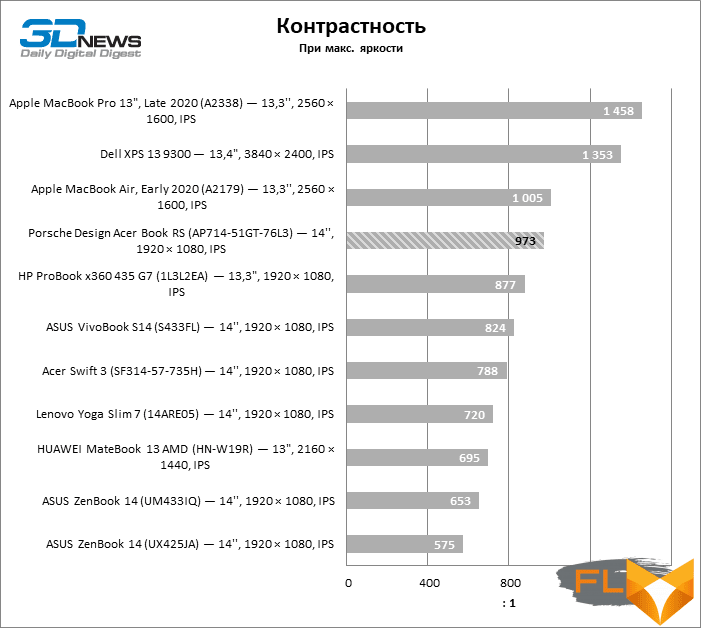
In addition, the Porsche Design Acer Book RS matrix is quite accurately tuned to a color temperature of 6500 K.
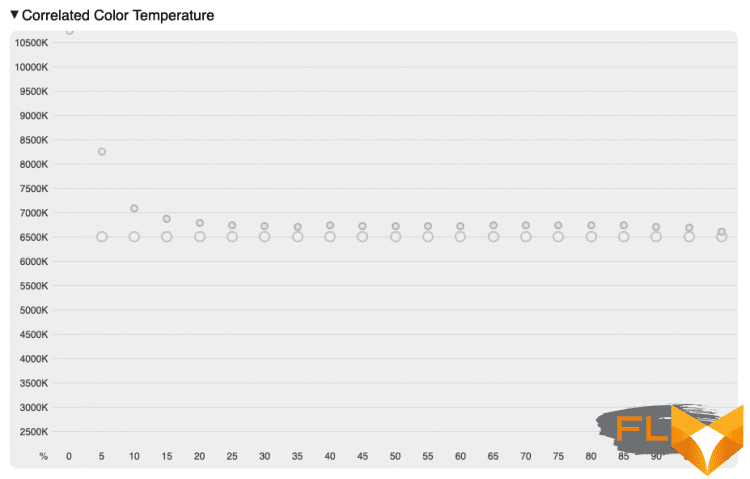
The same applies to the gamma correction curve approximated to the reference exponential function of 2.2.
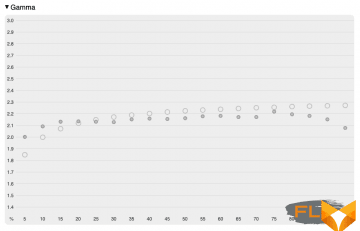 |
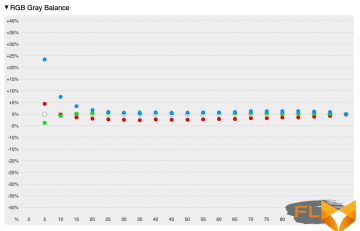 |
The color gamut exactly corresponds to the sRGB standard.

The result of a good matrix setting was excellent estimates of color accuracy: there is a serious deviation in only one shade. The backlight is uniform, there is no flickering of the screen noticeable to the naked eye at low brightness.
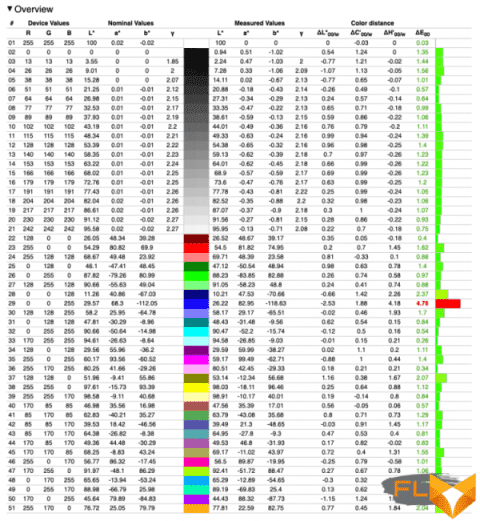
⇡#Clock speeds, temperature and noise levels
The Porsche Design Acer Book RS uses Intel’s Tiger Lake CPU, which replaces the previous generation of Ice Lake processors. However, both Ice Lake and Tiger Lake are manufactured at 10nm, so the new architecture didn’t bring a significant boost in clock speeds with it. Yes, the processor here clocks at 2.9 GHz with all four cores fully loaded, but this was achieved thanks to a TDP of 19 W, while all the Ice Lake samples that appear in our benchmarks are clamped into the 16 W power range. But compared to other 10th generation Intel processors, but already on a 14nm Comet Lake crystal, there is a big improvement: Tiger Lake develops higher clock speeds with the same average power and number of x86 cores. But of course, AMD’s Ryzen 4000 chips remain the main threat to Intel’s mobile CPUs. While the Ryzen 7 4700U falls behind the Intel Core i5-1035G7 at around 300MHz clock speed, it offers double the cores in return without having to raise the bar for sustainable power consumption.
Porsche Design manufacturer Acer Book RS has been curious about the machine’s GPU. Automation is configured so that under heavy load, when the temperature reaches 60 ° C, the GPU resets the clock speeds to 750 MHz, although it is designed for 1.5 GHz. We haven’t seen this yet, but it looks like it was otherwise impossible to leave some headroom in the cooling system for the CPU. When the GPU and CPU are fully loaded, the latter sags to 1.1 GHz anyway.
| Load Clock | ||||||||
|---|---|---|---|---|---|---|---|---|
| Cinebench R20 (Max thread no.) | LuxMark 3.1 | Cinebench R20 (max thread no.) + LuxMark 3.1 | ||||||
| CPU clock speed, MHz | GPU clock speed, MHz | CPU clock speed, MHz | GPU clock speed, MHz | |||||
| Medium | Max | Medium | Max | Medium | Max | Medium | Max | |
| Porsche Design Acer Book RS (AP714-51GT-76L3) – Intel Core i7-1165G7 / NVIDIA GeForce MX350 | 2893 | 2994 | 747 | 747 | 1142 | 1502 | 747 | 747 |
| ASUS VivoBook S14 (S433FL) — Intel Core i7-10510U / NVIDIA GeForce MX250 | 2555 | 3392 | 1550 | 1695 | 1804 | 2294 | 1248 | 1683 |
| ASUS ZenBook 14 (UM433IQ) — AMD Ryzen 7 4700U / NVIDIA GeForce MX350 — Standard | 2694 | 3419 | 1321 | 1493 | 1409 | 1637 | 1301 | 1493 |
| Dell XPS 13 9300 — Intel Core i7-1065G7 / Intel Iris Plus Graphics G7 — Ultra Performance | 1943 | 2794 | 842 | 898 | 1085 | 1397 | 616 | 798 |
| CPU and GPU power | ||||||||
|---|---|---|---|---|---|---|---|---|
| Cinebench R20 (Max thread no.) | LuxMark 3.1 | Cinebench R20 (max thread no.) + LuxMark 3.1 | ||||||
| CPU Wattage | GPU power consumption (SoC as a whole for iGPU), W | CPU Wattage | GPU Power Consumption (Total SoC for iGPU, W | |||||
| Medium | Max | Medium | Max | Medium | Max | Medium | Max | |
| Porsche Design Acer Book RS (AP714-51GT-76L3) – Intel Core i7-1165G7 / NVIDIA GeForce MX350 | 19 | 19 | 5 | 5 | 13 | 15 | 5 | 5 |
| ASUS VivoBook S14 (S433FL) – Intel Core i7-10510U / NVIDIA GeForce MX250 | 19 | 28 | N/A | N/A | 13 | 15 | N/A | N/A |
| ASUS ZenBook 14 (UM433IQ) – AMD Ryzen 7 4700U / NVIDIA GeForce MX350 – Standard | 19 | 30 | N/A | N/A | 10 | 10 | N/A | N/A |
| Dell XPS 13 9300 – Intel Core i7-1065G7 / Intel Iris Plus Graphics G7 – Ultra Performance | 16 | 29 | 15 | 15 | 15 | 20 | 15 | 15 |
Note The measurement is performed after the device has warmed up and all parameters have stabilized.
Although the Porsche Design Acer Book RS cooler is not designed to serve a CPU with an increased (relative to other ultrabooks) TDP while maintaining high GPU frequencies, without a serious load on the graphics, it guarantees a moderate CPU temperature in the range of 78 ° C and a comfortable , albeit not a record low, noise level. Alternative settings for clock speeds, power consumption and fan speed are not provided in the Porsche Design Acer Book RS, but, in truth, they are not needed – Acer engineers have already reached a balance between the main performance characteristics.
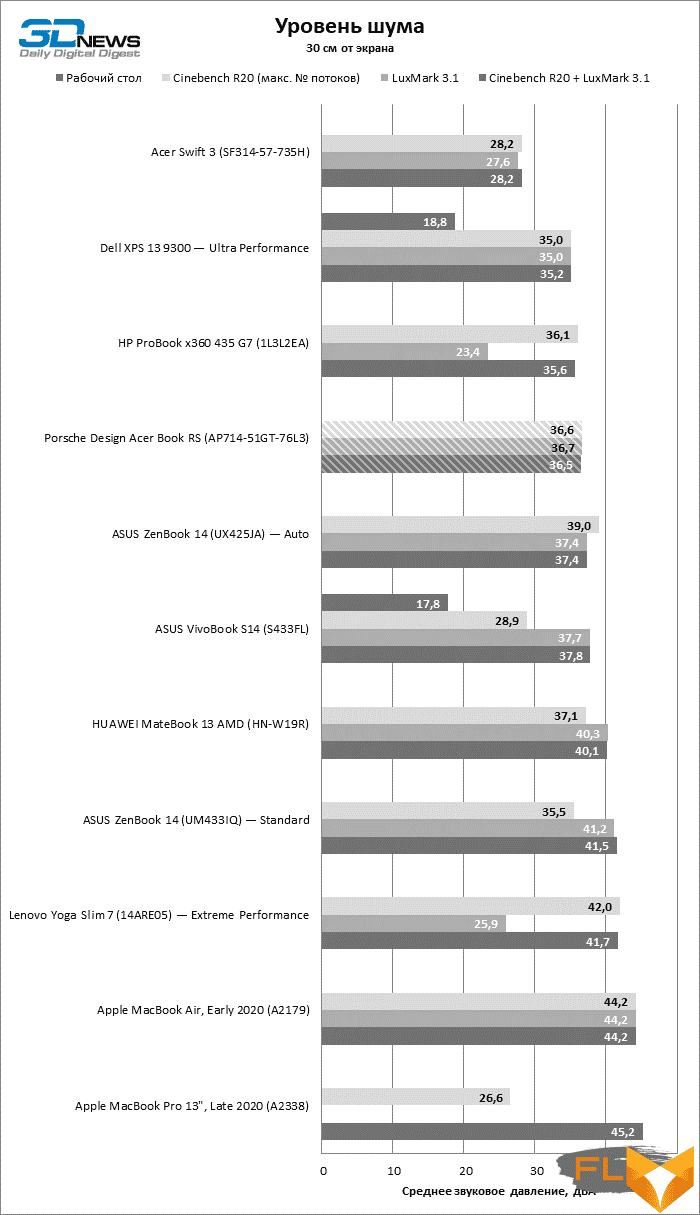
⇡#Synthetic Performance Tests
With high CPU clock speeds, the Porsche Design Acer Book RS leads the isolated processor benchmarks of the same form factor computers based on previous generation Intel chips, and in short benchmarks (such as Geekbench 4), Tiger Lake can compete with some configurations based on eight-core Ryzen 4000 (also with ARM’s Apple M1 chip in x86 emulation mode). But the main advantage of Tiger Lake is, of course, an outstanding level of single-threaded performance.

Strict temperature limits do not prevent the GeForce MX350 discrete video adapter from delivering performance at the level of conventional MX250 and MX350 varieties under short or not very intensive loads. This is an entry-level GPU designed for light gaming or GP-GPU support operations in production applications.
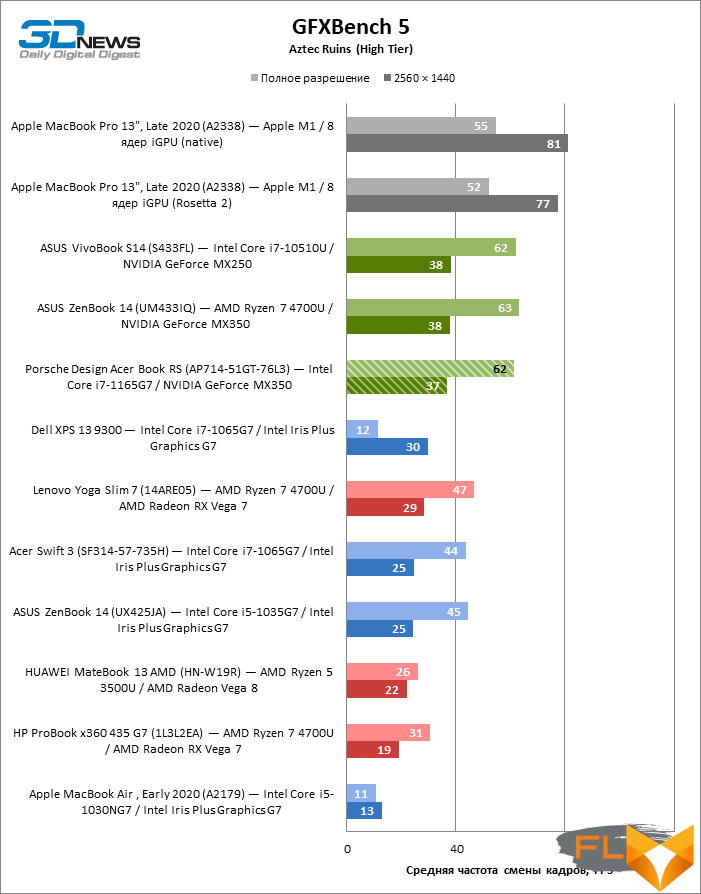
⇡#Performance in production applications
In terms of 3D rendering speed in Blender, powered by the Porsche Design CPU, the Acer Book RS outperforms all compact laptops based on Intel CPUs of the previous generation, yielding only to the “red” rivals based on the Ryzen 4000 and the MacBook Pro on the M1 chip. All thanks to the increased power reserve. But the limitation of the GeForce MX350 graphics core on heating makes itself felt in such tasks – because of it, the MX350 sank to the level of the MX250. In any case, even a weak discrete GPU is preferable to integrated graphics (unless you take into account the powerful integrated GPU-on-chip Apple M1).
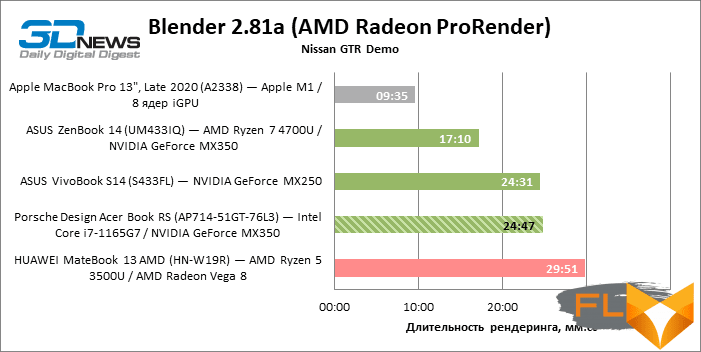
The progressive architecture of Tiger Lake excels in applications that rely on single-threaded CPU performance. The Lightroom and Photoshop benchmarks placed the Porsche Design Acer Book RS in first place among a host of rivals (including a MacBook Pro on an Apple M1 in x86 emulation mode).
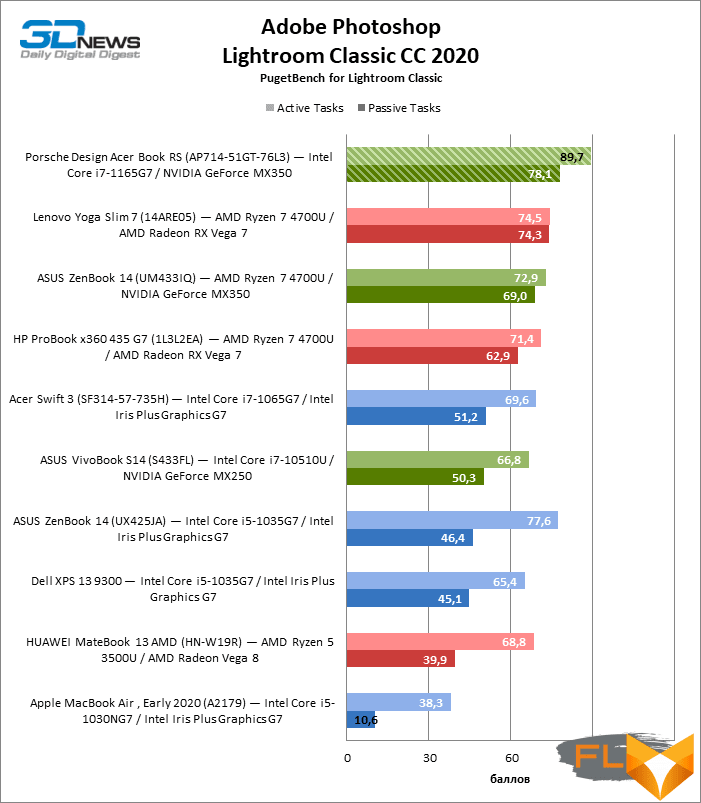
Note Scores are based on a percentage of the performance of a reference workstation with Intel Core i9-9900K, NVIDIA GeForce RTX 2080 and 64GB RAM.
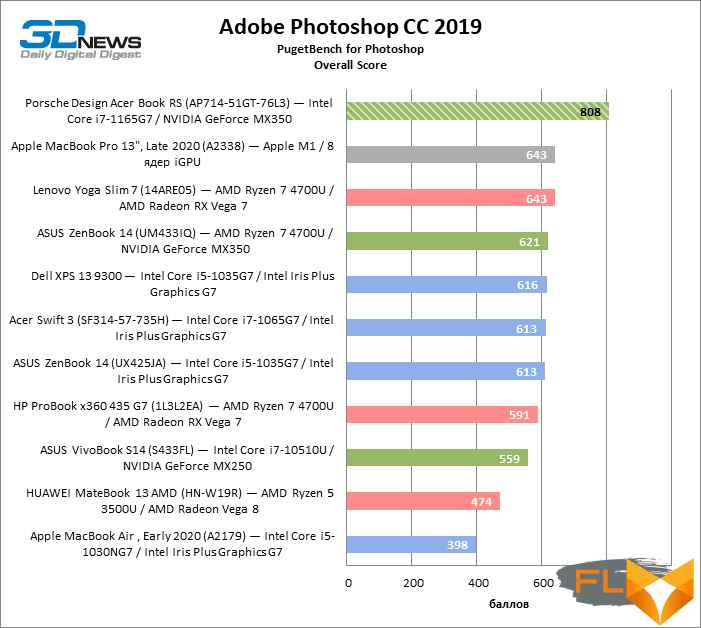
Note Scores are calculated as a percentage of the performance of a reference workstation with an Intel Core i9-9900K, NVIDIA GeForce RTX 2080 and 64GB of RAM times 10.
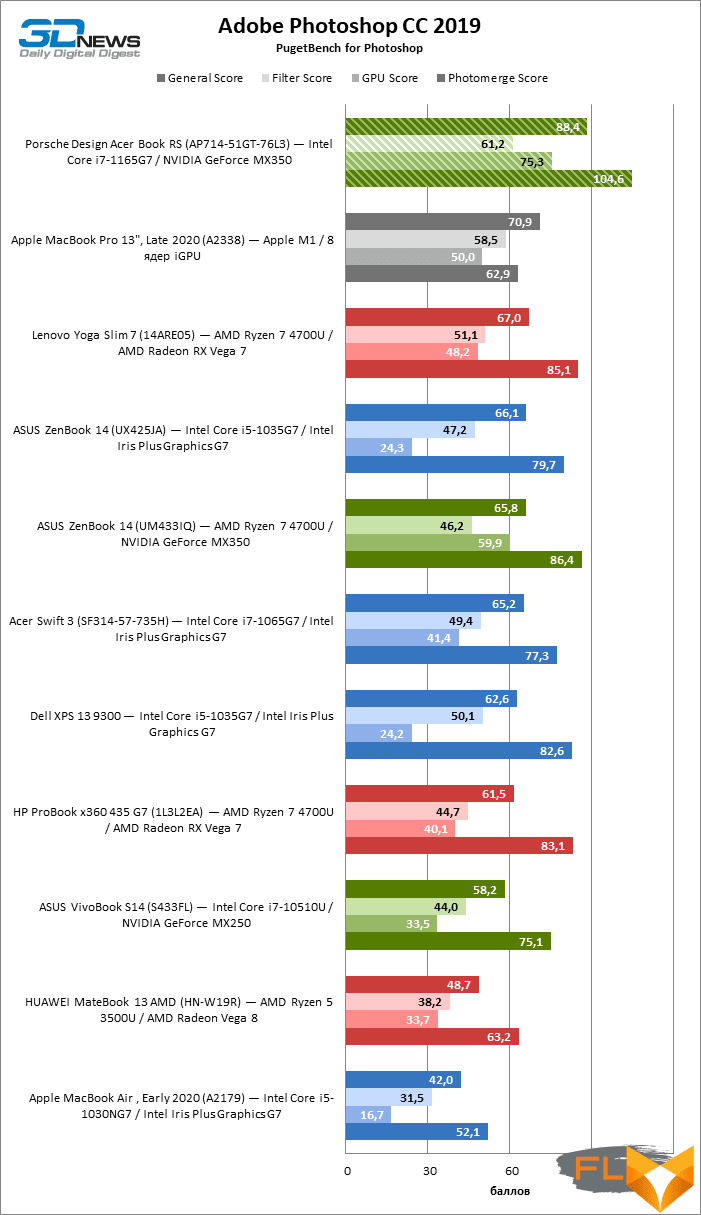
Note Scores are based on a percentage of the performance of a reference workstation with Intel Core i9-9900K, NVIDIA GeForce RTX 2080 and 64GB RAM.
The advantages of Tiger Lake chips extend to performance in the Premiere Pro video editor. The Porsche Design Acer Book RS’s only rival in project speed (assuming it’s not overloaded with GPU effects) is the MacBook Pro on the Apple M1. But the encoding speed still depends more on the number of processor cores – here the Ryzen 4000 (and again the Apple M1) is out of competition.
The tight GPU temperature in the Porsche Design Acer Book RS results in extremely low frame rate playback of a project with complex effects relying on the video adapter. However, if this is not the notorious MacBook on the M1, in an ultra-thin form factor you can not count on more or less responsive playback and high-speed encoding of 4K video in Premiere Pro, even when using a proxy.
 |
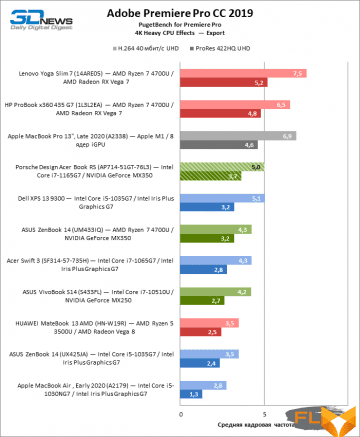 |
|
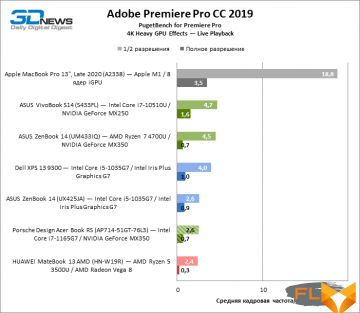 |
 |
⇡# SSD Performance
Our Porsche Design Acer Book RS is equipped with Western Digital’s inexpensive 1TB PC SN530 drive. It is connected to the system with four PCI Express 3.0 lanes, but it is not as fast as the common analogues from WD, Samsung and Micron. So, even with a relatively short load, the linear read and write speed on the PC SN530 drops to 1 GB / s or lower, which hardly meets the expectations of a modern NVMe-compatible SSD. Throughput in random read mode for PC SN530 also turned out to be the smallest among the compared drives. Only arbitrary recording is good for this device.
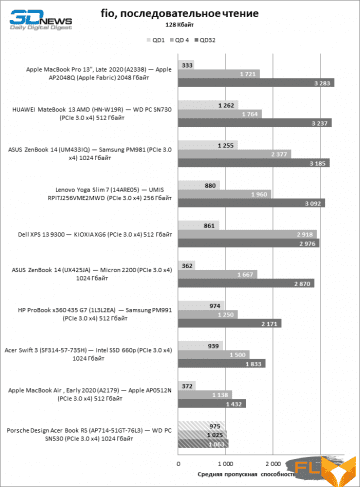 |
 |
|
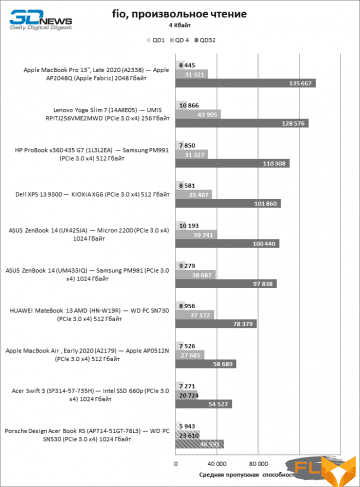 |
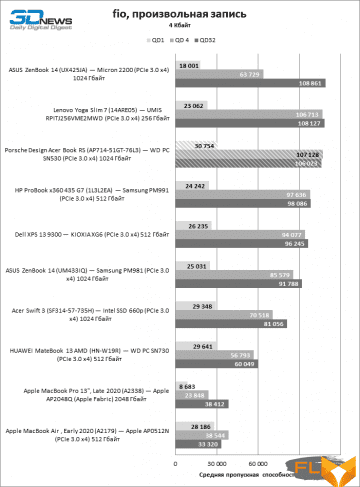 |
⇡# Battery Life
The Porsche Design Acer Book RS is equipped with a battery with a capacity of 54.5 Wh – quite typical for laptops of this form factor. What is atypical is the battery life on a single charge. The Porsche Design Acer Book RS delivered over 9 hours of continuous HEVC video playback and nearly 12 hours of web surfing without the tricks of limiting screen brightness to 150cd/m2 or below that other manufacturers don’t mind.
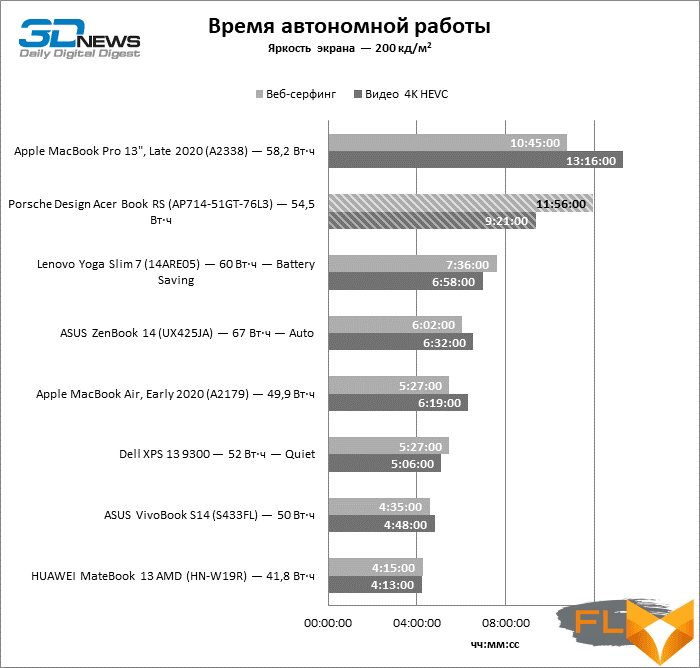
⇡#Conclusions
Thanks to Intel’s Tiger Lake processors, we can say that the time of unconditional dominance of Ryzen 4000 mobile chips in performance benchmarks has come to an end. With equal power headroom, there are plenty of applications that run better on four Tiger Lake cores with their single-threaded performance than on eight Ryzen cores, with Adobe’s “creative” applications being the clearest example. In addition, the updated silicon made it possible to significantly increase the battery life – this is clearly visible in the outstanding results of the Porsche Design Acer Book RS.
All this is the merit of Intel, but Acer also has something to brag about. Firstly, even in expensive ultrabooks, you still need to look for the same high-quality screen as the Porsche Design Acer Book RS. This is a bright and contrasting matrix with very accurate color reproduction out of the box. Secondly, Acer’s engineers managed to balance CPU clock speeds, component temperatures and cooling system noise levels well, despite the presence of a discrete GPU. Yes, the latter had to be severely limited in power, but with such dimensions of the chassis, this seems to be the best solution. Finally, the Porsche Design Acer Book RS chassis itself looks solid and is built just as well.
The only thing that prevents us from recommending the new Acer product for purchase without hesitation is the high price of the device. We’re far from judging laptops based on benchmarks without looking at everything else, but the Porsche Design Acer Book RS has worthy rivals, and most of them will cost significantly less. And in the context of a cost above 200 thousand rubles. Acer’s shortcomings, which are described in the Design and Ergonomics section, and the low speed of the SSD are already striking. But if the price is not embarrassing, then the advantages of this device outweigh the disadvantages, and there are not so many alternatives in overall quality to the Porsche Design Acer Book RS – despite the variety of offers on the ultrabook market.

